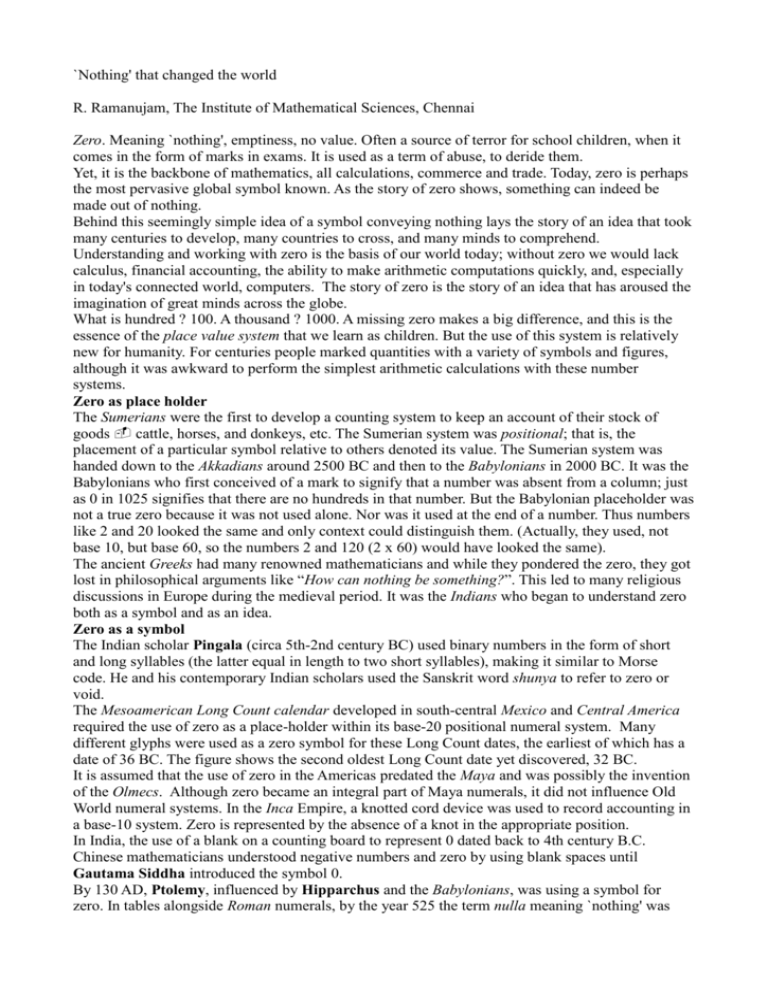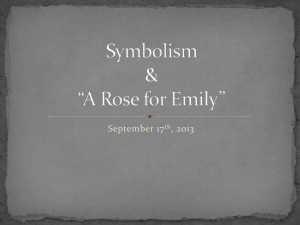onzero - The Institute of Mathematical Sciences
advertisement

`Nothing' that changed the world R. Ramanujam, The Institute of Mathematical Sciences, Chennai Zero. Meaning `nothing', emptiness, no value. Often a source of terror for school children, when it comes in the form of marks in exams. It is used as a term of abuse, to deride them. Yet, it is the backbone of mathematics, all calculations, commerce and trade. Today, zero is perhaps the most pervasive global symbol known. As the story of zero shows, something can indeed be made out of nothing. Behind this seemingly simple idea of a symbol conveying nothing lays the story of an idea that took many centuries to develop, many countries to cross, and many minds to comprehend. Understanding and working with zero is the basis of our world today; without zero we would lack calculus, financial accounting, the ability to make arithmetic computations quickly, and, especially in today's connected world, computers. The story of zero is the story of an idea that has aroused the imagination of great minds across the globe. What is hundred ? 100. A thousand ? 1000. A missing zero makes a big difference, and this is the essence of the place value system that we learn as children. But the use of this system is relatively new for humanity. For centuries people marked quantities with a variety of symbols and figures, although it was awkward to perform the simplest arithmetic calculations with these number systems. Zero as place holder The Sumerians were the first to develop a counting system to keep an account of their stock of goods cattle, horses, and donkeys, etc. The Sumerian system was positional; that is, the placement of a particular symbol relative to others denoted its value. The Sumerian system was handed down to the Akkadians around 2500 BC and then to the Babylonians in 2000 BC. It was the Babylonians who first conceived of a mark to signify that a number was absent from a column; just as 0 in 1025 signifies that there are no hundreds in that number. But the Babylonian placeholder was not a true zero because it was not used alone. Nor was it used at the end of a number. Thus numbers like 2 and 20 looked the same and only context could distinguish them. (Actually, they used, not base 10, but base 60, so the numbers 2 and 120 (2 x 60) would have looked the same). The ancient Greeks had many renowned mathematicians and while they pondered the zero, they got lost in philosophical arguments like “How can nothing be something?”. This led to many religious discussions in Europe during the medieval period. It was the Indians who began to understand zero both as a symbol and as an idea. Zero as a symbol The Indian scholar Pingala (circa 5th-2nd century BC) used binary numbers in the form of short and long syllables (the latter equal in length to two short syllables), making it similar to Morse code. He and his contemporary Indian scholars used the Sanskrit word shunya to refer to zero or void. The Mesoamerican Long Count calendar developed in south-central Mexico and Central America required the use of zero as a place-holder within its base-20 positional numeral system. Many different glyphs were used as a zero symbol for these Long Count dates, the earliest of which has a date of 36 BC. The figure shows the second oldest Long Count date yet discovered, 32 BC. It is assumed that the use of zero in the Americas predated the Maya and was possibly the invention of the Olmecs. Although zero became an integral part of Maya numerals, it did not influence Old World numeral systems. In the Inca Empire, a knotted cord device was used to record accounting in a base-10 system. Zero is represented by the absence of a knot in the appropriate position. In India, the use of a blank on a counting board to represent 0 dated back to 4th century B.C. Chinese mathematicians understood negative numbers and zero by using blank spaces until Gautama Siddha introduced the symbol 0. By 130 AD, Ptolemy, influenced by Hipparchus and the Babylonians, was using a symbol for zero. In tables alongside Roman numerals, by the year 525 the term nulla meaning `nothing' was used (but as a word). In 498 AD, the Indian mathematician and astronomer Aryabhata stated that “Sthanam sthanam dasa gunam” or place to place in ten times in value, which is the origin of the modern decimalbased place value notation. The oldest known text to use a decimal place-value system, including a zero, is the Jain text from India entitled the Lokavibhaga, dated 458 AD. This text uses Sanskrit numeral words for the digits, with words for zero such as the Sanskrit word for `void' or `empty', shunya. The first known use of special glyphs for the decimal digits that includes the indubitable appearance of a symbol for the digit zero, a small circle, appears on a stone inscription found at the Chaturbhuja Temple at Gwalior in India, dated 876 AD. The mathematical zero Brahmagupta, around 650 AD, was the first to formalize arithmetic operations using zero. He used dots underneath numbers to indicate a zero. In the book book Brahmasputha Siddhanta (628 AD), he wrote standard rules for reaching zero through addition and subtraction as well as the results of operations with zero. The only error in his rules was division by zero, which would have to wait for Isaac Newton and G.W. Leibniz to tackle. His rules were: The sum of zero and a negative number is negative. The sum of zero and a positive number is positive. The sum of zero and zero is zero. The sum of a positive and a negative is their difference; or, if their absolute values are equal, zero. A positive or negative number when divided by zero is a fraction with the zero as denominator. Zero divided by a negative or positive number is either zero or is expressed as a fraction with zero as numerator and the finite quantity as denominator. Zero divided by zero is zero. The great Arabian voyagers brought the texts of Brahmagupta and his colleagues back from India along with spices and other exotic items. Zero reached Baghdad by 773 AD and was developed by Arabian mathematicians who would base their numbers on the Indian system. In the ninth century, Mohammed ibn-Musa al-Khowarizmi was the first to work on equations that equalled zero, or algebra as it has come to be known. He also developed quick methods for multiplying and dividing numbers known as algorithms (a corruption of his name). By 879 AD, zero was written almost as we now know it, an oval - but in this case smaller than the other numbers. Etymology Al-Khowarizmi called zero `sifr', from which the word `cipher' is derived. In Arabic, safira means `it is empty', and was a translation of the Sanskrit word shunya meaning `empty'. `Sifr' became `zefiro' in Italian, then `zero' in Venetian, became `zero' in French, which led to the English zero. Zero in commerce The Italian mathematician, Fibonacci, built on Al-Khowarizmi's work with algorithms in his book Liber Abaci, or `Abacus book', in 1202. Fibonacci's developments quickly gained notice by Italian merchants and German bankers, especially the use of zero. Accountants knew their books were balanced when the positive and negative amounts of their assets and liabilities equalled zero. But governments were still suspicious of Arabic numerals because of the ease in which it was possible to change one symbol into another. Though outlawed, merchants continued to use zero in encrypted messages, thus the derivation of the word cipher, meaning code, from the Arabic sifr. Zero in its glory Rene Descartes, the founder of the Cartesian coordinate system, chose (0,0) as the origin. Although zero was now becoming more common, the developers of calculus, Newton and Lebiniz, would make the final step in understanding zero. Adding, subtracting, and multiplying by zero are relatively simple operations. But division by zero has confused even great minds. How many times does zero go into ten? Or, how many non-existent apples go into two apples? The answer is indeterminate, but working with this concept is the key to calculus. When you look out, you probably see a car or bus speeding on the road. How would you measure the speed of the car at any one instant ? You would have to measure the change in speed that occurs over a set period of time. By making that set period smaller and smaller, you could reasonably estimate the speed at that instant. In effect, as you make the change in time approach zero, the ratio of the change in speed to the change in time becomes similar to some number over zero - the same problem that stumped Brahmagupta. In the 1600's, Newton and Leibniz solved this problem independently. By working with numbers as they approach zero, calculus was born. without which we wouldn't have physics, engineering, economics and finance. As a number 0 is the integer immediately preceding 1. In most cultures, 0 was identified before the idea of negative things (quantities) that go lower than zero was accepted. Zero is an even number because it is divisible by 2. 0 is neither positive nor negative. By most definitions 0 is a natural number, and then the only natural number not to be positive. Zero is a number which quantifies a count or an amount of null size. In algebra Zero is a whole number and hence a rational number and a real number (as well as an algebraic number and a complex number). It is neither positive nor negative and appears in the middle of the number line. It is neither a prime number nor a composite number. It cannot be prime because it has an infinite number of factors and cannot be composite because it cannot be expressed by multiplying prime numbers (0 must always be one of the factors). The following are some basic (elementary) rules for dealing with the number 0. These rules apply for any real or complex number x, unless otherwise stated. Addition: x + 0 = 0 + x = x. That is, 0 is an identity element (or neutral element) with respect to addition. Subtraction: x 0 = x and 0 x = x. Multiplication: x · 0 = 0 · x = 0. Division: 0/x = 0, for nonzero x. But x/0 is undefined, because 0 has no multiplicative inverse (no real number multiplied by 0 produces 1), a consequence of the previous rule. Exponentiation: x0 = x/x = 1, except that the case x = 0 may be left undefined in some contexts. For all positive real x, 0x = 0. The expression 0/0 is called an “indeterminate form”. The sum of 0 numbers is 0, and the product of 0 numbers is 1. The factorial 0! evaluates to 1. Elsewhere in mathematics In set theory, 0 is the cardinality of the empty set: if one does not have any apples, then one has 0 apples. In fact, in certain axiomatic developments of mathematics from set theory, 0 is defined to be the empty set. In propositional logic, 0 may be used to denote the truth value. In abstract algebra, 0 is commonly used to denote a zero element, which is a neutral element for addition (if defined on the structure under consideration) and an absorbing element for multiplication (if defined). A zero of a function f is a point x in the domain of the function such that f(x) = 0. When there are finitely many zeros these are called the roots of the function. The zero function (or zero map) on a domain D is the constant function with 0 as its only possible output value, i.e., the function f defined by f(x) = 0 for all x in D. In the sciences In Physics, the value zero plays a special role for many physical quantities. For example, on the Kelvin temperature scale, zero is the coldest possible temperature (negative temperatures exist but are not actually colder). The zero-point energy is the lowest possible energy that a quantum mechanical physical system may possess and is the energy of the ground state of the system.








